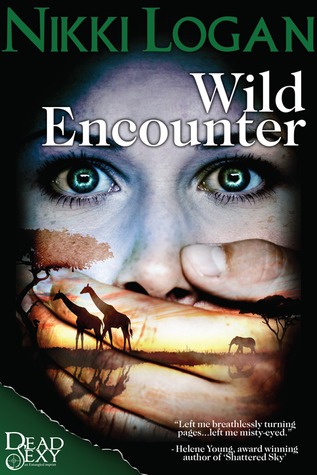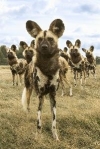Happy Friday, Feasters! Are you feeling all spring-y? Isn’t it wonderful to see the sun and experience its lovely warm caress again? Very difficult to feel down when the sky is clear and blue, plants are in flower and nature’s creatures are bouncing around all a-frisky.
Ooh, and speaking of nature’s creatures, we have a rather different focus today. Yes, m’dears, Friday Feast is going  animal! And so it should. I mean it’s not every day you get a multi-published author and zoo worker regaling you with tales, is it?
animal! And so it should. I mean it’s not every day you get a multi-published author and zoo worker regaling you with tales, is it?
Romance with Nature is Australian author Nikki Logan’s catchphrase and how wonderfully she does it too. Whether it’s one of Nikki’s many captivating Harlequin Romance novels or a heart-pumping romantic suspense, you’ll be caught up in her vivid, wild environments and beautiful, passionate love stories.
Just check out her new release, Wild Encounter.
WILD ENCOUNTER
 A wildlife release mission in Africa turns deadly when the convoy is hijacked by smugglers, and veterinarian Clare Delaney is taken hostage. Terrified for her life and her animals, the intrepid Clare establishes a rapport with the man she believes is the criminals’ leader, and reluctantly finds herself under his protection…and falling hard for the enigmatic man.
A wildlife release mission in Africa turns deadly when the convoy is hijacked by smugglers, and veterinarian Clare Delaney is taken hostage. Terrified for her life and her animals, the intrepid Clare establishes a rapport with the man she believes is the criminals’ leader, and reluctantly finds herself under his protection…and falling hard for the enigmatic man.
Alpha-to-the-max Simon deVries sees right through his sexy captive’s attempt to seduce her way to freedom. So when their simmering attraction flares into true passion, it takes them both by surprise. Now he’s torn between completing his secret mission and letting her escape without telling her his true identity. He knows if he lets her go, he will be risking his career, his life…and his heart.
Ooh, I’m a sucker for an African tale. Add in a sexy hero and a wild romance and I’m there. And so could you be! One click and Wild Encounter will be all yours. Go on. You know you want to…
Done? Excellent. Now you can have Nikki!
What To Feed Your Own Zoo
Working in a zoo you get to see and hear a lot of things related to the nutrition of different species. I bring a lot of ideas home to my own ‘pack’. Food enrichment ideas and activities to make the fur-kids work harder for their food and get more enjoyment from it.
The key to an effective captive diet (for any animal, including yours at home) is to replicate the wild one as much as possible. Not just the obvious stuff —wolves eat meat therefore my dog should eat meat—but the incidental diet elements too. Wolves eat meat, and hide, and leathery tendons, and whatever was in its prey’s stomach.
Numbats, for instance, spend huge parts of their day foraging for termites—their primary nutrition source. But while they busily ingest 20,000 termites a day (!), they’re also accidentally ingesting the semi-digested timber and grit inside the termites as well as the material from the termite mound that they accidentally ingest as they tongue-up thousands of termites a day. Their bodies have evolved to not just tolerate but also require that natural fibre for good digestive function. So much so that zookeepers at Perth Zoo grind up chunks of the termite’s nest mound and sprinkle it on their food like cinnamon on eggnog.
(Look at that little one on its back… so cute.)
Cathryn said you guys love recipes… here’s one for you. A termite-charged numbat slurpee courtesy of Perth Zoo.
Ingredients
Water | Eggs | Low-lactose milk powder | Ground up termites | Live Termites (two species) | Ground up mound material | Calcium | Vitamins |
· Mix water, eggs, milk-powder and cook until like custard in consistency.
· Mix in crushed-up termites and live termites
· Sprinkle ground-up mound material, calcium and vitamins
· Serve chilled
Mmm-mmm. I’m sure you’re all rushing off to make some right now.
Why am I talking about numbats? Because they’re so very, very adorabubble. Here’s one we prepared earlier.
Similarly, the big carnivores may be ‘meat eaters’ but they predate almost exclusively on grazing animals and so a percentage of their weekly diet is green stuff. Pre-chewed, half-digested greenstuff but plant material, nonetheless. So a certain amount of ‘greens’ is good for carnivores, too.
Note ‘weekly’ diet. Not ‘daily’. Grass grazers [zebra|deer|pig|birds], fruit pickers [birds|monkeys|rodents] and leaf browsers [elephants|giraffe|kangaroo] tend to spend most of their day foraging for their plant-based food because of its lower nutritional value and relative abundance. But while the top end carnivores have an energy-rich, concentrated meat diet, it does come at a price. They use a lot more energy catching it, they fail as often as they succeed, and sometimes food is just really hard to come by. Or to keep.
Wild dogs, for example, will work in packs, expending enormous amounts of collective energy tracking the right prey (the slowest, the weakest, the least experienced, the most vulnerable), isolating it and then hunting it down. They’re efficient, humane killers once they’ve done that but more often than not as soon as they’ve done all the hard work and settled in for a good feed, along will come a larger prey (lion, hyaena, leopard) and steal their feed out from under their paws. Compared to the muscle-mass of the larger carnivores, wild dogs are pretty rangy and that’s basically because their protein intake is only *just* ahead of their energy expenditure. They go hungry more often than not, work super-hard for their food and—unlike the other ‘me, me, it’s all about me’ carnivores—wild dogs make sure the weak and young are fed first. So a rangy alpha is a good alpha. It means he’s looking after his pack.
Why am I talking about wild dogs? Because I really respect their carnivore values and because I have a romantic suspense called ‘Wild Encounter’ out this week through Entangled which features them. My heroine is up to her elbows in moving a pack of unconscious and endangered wild dogs across African borders when she and the dogs are kidnapped by wildlife traffickers. I got to spend months researching these beautiful, unique animals and their quirky ways and the affection has stuck.
moving a pack of unconscious and endangered wild dogs across African borders when she and the dogs are kidnapped by wildlife traffickers. I got to spend months researching these beautiful, unique animals and their quirky ways and the affection has stuck.
Just like your dogs at home, animals which are biologically adapted to be foraging and working hard for their food risk becoming overweight if their food is plonked in twice a day and the only thing they have to do for it is haul themselves up and walk to a bowl. So good zoos will implement behavioural enrichment challenges for their captive creatures to make sure that the have to work for their daily food allowance.
(BTW, every single one of these you can do at home for your own captive collection…I’ve modified them for your average suburban kitchen and not the industrial zoo food prep areas…) There’s so much we can do for our backyard zoo just by taking the lead of the people who look after animals for a living.
Frozen icies: boil up a stock using dinner bones or the left-over blood from the meat tray of your next roast and some water. Freeze a portion, then layer in some small treats and splash a tiny bit of blood stock on them. Freeze to bond them in place. Then add more stock, freeze. Repeat. That way you have a tasty, lickable, layered snack for a hot day that will keep the animal engaged and active. (You can do this for nectar loving birds with diluted peach-juice for stock and fruit pieces inside. Or horses with a super diluted molasses mix and apple/carrot bits inside.)
Scatter feeds: withhold 1/3 of the animal’s daily food and hide it around their environment. Under plants, wedged in logs, tucked in corners, smeared on sticks, buried in sandpits. Release the animal into the environment and watch them go—hunting and foraging like a pro and using all their natural behaviours. (This is also a great one for pets who suffer separation anxiety because they’re so engaged with the ‘hunt’ they don’t have time to indulge the addictive anxiety behaviours as you leave for the day.)
Stuffed pinecones (great for cockies): Take an open pinecone and wedge unsalted, unbuttered popcorn into the crevices. Hang on a hook in the aviary.
Carcass feed: in zoos, carnivores can be fed entire or half-carcasses which gives them a chance to really work out those natural predator muscles. Zookeepers suspend them from bungees, or affix them to flying foxes so the predators have to chase their ‘kill’. At home you can give dogs entire kangaroo tails (hide-on) and tie them to a post so they can play tug-of-war.
Puzzle boxes: put some food treats in a discarded toilet roll stuffed with straw. Wrap it in old newspaper. Hide in the garden. Messy but so much fun!
So that’s it. The ideas are as unlimited as your imagination. The secret is to understand what your animal’s wild behaviours would have been and then to find ways to stimulate those.
Good luck! Let me know here if you have any enrichment ideas of you own or if you have any success with one of the above.
*Nikki*
How cool was that? A bit different to our usual Friday Feasts but variety is indeed the spice of life, although I can’t imagine I’ll be whipping up any termite slurpees anytime soon. Not deliberately, anyway.
What tricks do you use to keep your menagerie amused or well-fed? My mum used to pong the house out cooking up kangaroo mince mush for the dogs. And my beloved collie, Cooch (darling, darling doggie), had a real thing for horse hoof trimmings. Absolutely loved them. Suppose it was like the canine equivalent of biting someone else’s toenails…
Nikki and I would love to hear your tales (or tails!), so get a-commenting!
If you’d like to learn more about Nikki and her romance with nature, please visit her website. You can also connect via Facebook and Twitter. Or check out her trailer on YouTube.



Comments are closed